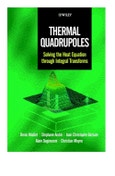This superb text describes a novel and powerful method for allowing design engineers to firstly model a linear problem in heat conduction, then build a solution in an explicit form and finally obtain a numerical solution. It constitutes a modelling and calculation tool based on a very efficient and systemic methodological approach.
Solving the heat equations through integral transforms does not constitute a new subject. However, finding a solution generally constitutes only one part of the problem. In design problems, an initial thermal design has to be tested through the calculation of the temperature or flux field, followed by an analysis of this field in terms of constraints. A modified design is then proposed, followed by a new thermal field calculation, and so on until the right design is found. The thermal quadrupole method allows this often painful iterative procedure to be removed by allowing only one calculation.
The chapters in this book increase in complexity from a rapid presentation of the method for one dimensional transient problems in chapter one, to non uniform boundary conditions or inhomogeneous media in chapter six. In addition, a wide range of corrected problems of contemporary interest are presented mainly in chapters three and six with their numerical implementation in MATLAB (r) language. This book covers the whole scope of linear problems and presents a wide range of concrete issues of contemporary interest such as harmonic excitations of buildings, transfer in composite media, thermal contact resistance and moving material heat transfer. Extensions of this method to coupled transfers in a semi-transparent medium and to mass transfer in porous media are considered respectively in chapters seven and eight. Chapter nine is devoted to practical numerical methods that can be used to inverse the Laplace transform.
Written from an engineering perspective, with applications to real engineering problems, this book will be of significant interest not only to researchers, lecturers and graduate students in mechanical engineering (thermodynamics) and process engineers needing to model a heat transfer problem to obtain optimized operating conditions, but also to researchers interested in the simulation or design of experiments where heat transfer play a significant role.
Solving the heat equations through integral transforms does not constitute a new subject. However, finding a solution generally constitutes only one part of the problem. In design problems, an initial thermal design has to be tested through the calculation of the temperature or flux field, followed by an analysis of this field in terms of constraints. A modified design is then proposed, followed by a new thermal field calculation, and so on until the right design is found. The thermal quadrupole method allows this often painful iterative procedure to be removed by allowing only one calculation.
The chapters in this book increase in complexity from a rapid presentation of the method for one dimensional transient problems in chapter one, to non uniform boundary conditions or inhomogeneous media in chapter six. In addition, a wide range of corrected problems of contemporary interest are presented mainly in chapters three and six with their numerical implementation in MATLAB (r) language. This book covers the whole scope of linear problems and presents a wide range of concrete issues of contemporary interest such as harmonic excitations of buildings, transfer in composite media, thermal contact resistance and moving material heat transfer. Extensions of this method to coupled transfers in a semi-transparent medium and to mass transfer in porous media are considered respectively in chapters seven and eight. Chapter nine is devoted to practical numerical methods that can be used to inverse the Laplace transform.
Written from an engineering perspective, with applications to real engineering problems, this book will be of significant interest not only to researchers, lecturers and graduate students in mechanical engineering (thermodynamics) and process engineers needing to model a heat transfer problem to obtain optimized operating conditions, but also to researchers interested in the simulation or design of experiments where heat transfer play a significant role.
Table of Contents
Interest in the Quadrupole Approach.Linear Conduction and Simple Geometries.
One-Dimensional Quadrupoles.
Multidimensional Transfers.
Time-Dependent Periodic Regimes.
Advanced Quadrupoles.
Mass Transfer in a Porous Medium.
The Quadrupole Approach Applied to Heat Transfer in Semi-Transparent Materials.
Inverse Laplace Transform.
Appendices.
Index.








